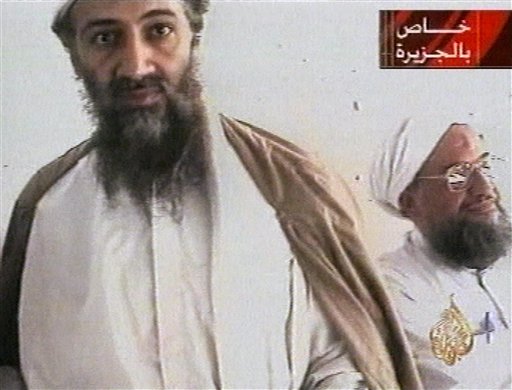WASHINGTON – In his final months padding around the dark third-floor room in his cinderblock Pakistan hide-out, the world’s most notorious terrorist mastermind spent a lot of time in his own head.
He fretted about his public image and the legacy of his organization. He wondered whether he had misnamed it al-Qaida. He fired off orders, handed out promotions, denied requests for help from the battlefield and sought to direct publicity for the looming 10th anniversary of the Sept. 11, 2001, attacks. And as well, he schemed to kill the man who would, in the end, give the order to shoot him dead: Barack Obama.
That’s the portrait of Osama bin Laden painted by the slim collection of notes and letters made public Thursday by the Combating Terrorism Center, a think tank at the U.S. Military Academy at West Point. The 17 documents represent a sliver of the vast cache of material on computer hard disks, flash drives and DVDs that Navy SEALs scooped up from bin Laden’s compound after they found him a year ago in his bedroom and put a bullet in his face.
The documents offer few revelations about how bin Laden evaded the United States for nearly a decade. But they do provide, with granular detail, selective insights into the mind of the terrorist leader during the years he was on the run.
What is missing from the tightly controlled release are details of who may have protected him, and how America’s Public Enemy No. 1 had spent years just a mile from Pakistan’s own version of West Point, the prestigious Kakul military academy in Abbottabad.
During those years, the documents indicate, bin Laden was haunted by al-Qaida’s failures and sought to recast his revolution. He concerned himself with the organization’s inabilities to launch a second large-scale attack in the United States, to capitalize on resentment that fueled the “Arab Spring” and to retain the trust and loyalty of Sunni Arab tribes in western Iraq.
Al-Qaida’s experience in Iraq weighed heavily on bin Laden. He saw how beheadings and indiscriminate bombings that led to scores of Muslim civilian deaths turned the tribes against the group, pushing tribal leaders into an alliance with the U.S. military.
“Bin Laden appeared to be deeply concerned that affiliates could go too far by killing too many people,” said Seth Jones, an expert on al-Qaida at the Santa Monica, Calif.-based Rand Corp. think tank and author of “Hunting in the Shadows: The Pursuit of al Qa’ida Since 9/11.”
Concerned that a “large portion” of Muslims had lost their trust in al-Qaida, bin Laden even floated new names for his organization. He felt that continuing to call the group al-Qaida “reduces the feeling of Muslims that we belong to them.”
Al-Qaida means “the base” and was a name that emerged from the organization’s origins in the base camps for fighters in Pakistan training to launch attacks on Soviet forces occupying Afghanistan in the 1980s. Bin Laden pondered ideas for a new name to better embrace the Muslim world, the contenders including: Muslim Unity Group, Islamic National Unification Party or Monotheism and Jihad Group.
Bin Laden continued to order that holy war be waged thousands of miles away. He could only see the world in shadows, flickering on his television set and computer screen, or described to him through letters and Arabic translations of American news reports.
He developed a sort of talk radio view of U.S. politics. At the same time, he could no longer trust that his commands were being followed, or whether his subordinates still revered him.
“I don’t think he had understood that al-Qaida had long passed him by,” said Jarret Brachman, a consultant to the U.S. government on the leadership of terrorist organizations and the author of “Global Jihadism: Theory and Practice.”
Among the plans that never came to fruition was a plot to kill Obama. Bin Laden ordered a lieutenant to set up a terrorist team near Bagram air base in Afghanistan that would be ready to blow up the president’s plane if he arrived for a surprise visit, as he eventually did Tuesday, the first anniversary of bin Laden’s death.
Bin Laden wrote in a letter to one of his lieutenants that assassinating Obama would put a “totally unprepared” Vice President Joe Biden in charge of the country, “which will lead the U.S. into a crisis.”
He also continued to express a need to maintain personal control, demanding that affiliates in Yemen, Somalia and North Africa stop fighting regional battles and help him focus on attacking the West.
He told the head of the Yemen affiliate that he shouldn’t declare an Islamic state there as long as “the enemy continues to possess the ability to topple any state we establish.”
The small selection of letters seems to show a bin Laden who may have grown apart from his longtime deputy, Egyptian-born surgeon Ayman al-Zawahri, and come to rely on the judgment of Libyan-born Atiyah Rahman, who was killed in a predator drone strike in August 2011. In the letters, Rahman and bin Laden also lament the rash and short-sighted leadership shown by a new generation of leaders rising through the ranks.
Send questions/comments to the editors.



Success. Please wait for the page to reload. If the page does not reload within 5 seconds, please refresh the page.
Enter your email and password to access comments.
Hi, to comment on stories you must . This profile is in addition to your subscription and website login.
Already have a commenting profile? .
Invalid username/password.
Please check your email to confirm and complete your registration.
Only subscribers are eligible to post comments. Please subscribe or login first for digital access. Here’s why.
Use the form below to reset your password. When you've submitted your account email, we will send an email with a reset code.